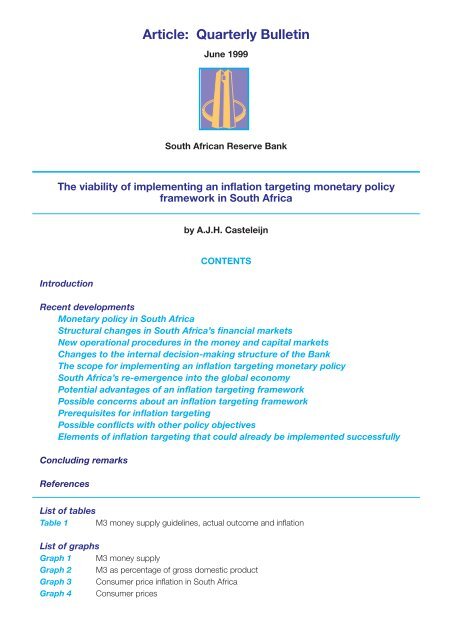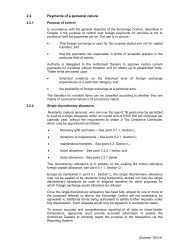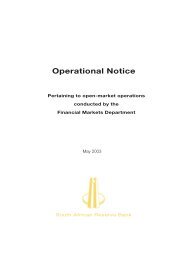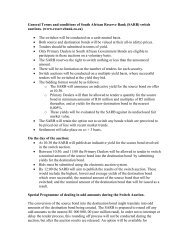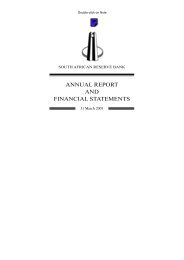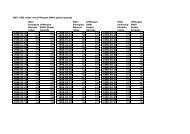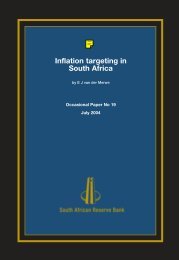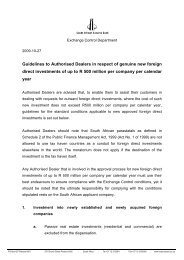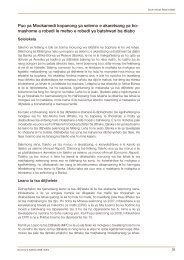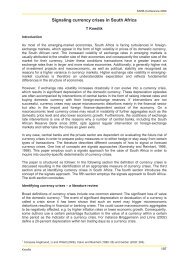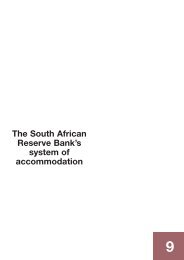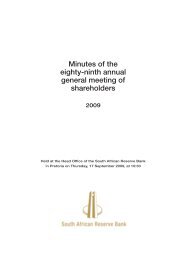Article: Quarterly Bulletin - South African Reserve Bank
Article: Quarterly Bulletin - South African Reserve Bank
Article: Quarterly Bulletin - South African Reserve Bank
Create successful ePaper yourself
Turn your PDF publications into a flip-book with our unique Google optimized e-Paper software.
<strong>Article</strong>: <strong>Quarterly</strong> <strong>Bulletin</strong><br />
June 1999<br />
<strong>South</strong> <strong>African</strong> <strong>Reserve</strong> <strong>Bank</strong><br />
The viability of implementing an inflation targeting monetary policy<br />
framework in <strong>South</strong> Africa<br />
by A.J.H. Casteleijn<br />
Introduction<br />
CONTENTS<br />
Recent developments<br />
Monetary policy in <strong>South</strong> Africa<br />
Structural changes in <strong>South</strong> Africa’s financial markets<br />
New operational procedures in the money and capital markets<br />
Changes to the internal decision-making structure of the <strong>Bank</strong><br />
The scope for implementing an inflation targeting monetary policy<br />
<strong>South</strong> Africa’s re-emergence into the global economy<br />
Potential advantages of an inflation targeting framework<br />
Possible concerns about an inflation targeting framework<br />
Prerequisites for inflation targeting<br />
Possible conflicts with other policy objectives<br />
Elements of inflation targeting that could already be implemented successfully<br />
Concluding remarks<br />
References<br />
List of tables<br />
Table 1 M3 money supply guidelines, actual outcome and inflation<br />
List of graphs<br />
Graph 1 M3 money supply<br />
Graph 2 M3 as percentage of gross domestic product<br />
Graph 3 Consumer price inflation in <strong>South</strong> Africa<br />
Graph 4 Consumer prices
The viability of implementing an inflation targeting<br />
monetary policy framework in <strong>South</strong> Africa 1)<br />
by A.J.H. Casteleijn<br />
A number of countries have successfully adopted inflation targeting monetary policy frameworks in recent years. It is a<br />
framework based on hitting an inflation target, and if it is considered that the target is going to be missed, then determining<br />
whether a change in policy stance is called for. The purpose of this paper is to briefly assess the viability of implementing<br />
an inflation targeting monetary policy framework in <strong>South</strong> Africa. The main conclusion is that a fully-fledged inflation<br />
targeting framework would ensure better co-ordination of monetary and fiscal policy and greater economic policy<br />
credibility. There are, however, two important caveats: approval of an explicit inflation targeting framework by government<br />
through the Minister of Finance and provision for a lead time of two to three years as part of the implementation strategy.<br />
Introduction<br />
Significant success has been achieved with the monetary<br />
policy model of the <strong>South</strong> <strong>African</strong> <strong>Reserve</strong> <strong>Bank</strong> during<br />
the past decade. However, important structural changes<br />
in the <strong>South</strong> <strong>African</strong> financial system in recent years have<br />
altered the transmission mechanism and weakened the<br />
more stable relationships that previously existed between<br />
changes in the money supply and in bank credit extension,<br />
on the one hand, and in nominal spending on<br />
goods and services and in prices on the other hand.<br />
Changes in the monetary aggregates have for the time<br />
being lost some of their usefulness as the most important<br />
indicators of possible future trends in inflation, and<br />
therefore also as an anchor for monetary policy decisions.<br />
The <strong>Reserve</strong> <strong>Bank</strong> has tentatively assumed a goal of<br />
maintaining inflation at a level that would be more or less<br />
in line with the average rate of inflation in the economies<br />
of <strong>South</strong> Africa’s major trading partners and international<br />
competitors. In the current international inflation environment<br />
this translates into an inflation rate of between 1<br />
and 5 per cent per annum. The Governor of the <strong>South</strong><br />
<strong>African</strong> <strong>Reserve</strong> <strong>Bank</strong> has, however, stated that <strong>South</strong><br />
Africa could under ideal circumstances gradually move<br />
towards targeting inflation directly: “In the [altered]<br />
situation, <strong>South</strong> Africa has to consider more seriously the<br />
introduction of inflation targets as an anchor for monetary<br />
policy purposes” (see Stals 1999).<br />
The paper briefly reviews the general prerequisites<br />
that still need to be met before a fully-fledged inflation<br />
targeting framework could be successfully introduced in<br />
1)<br />
A previous version of this paper was presented at a five-day<br />
workshop on the Choice of Intermediate Monetary Policy<br />
Targets in Industrial, Transitional and Developing<br />
Economies at the <strong>Bank</strong> of England’s Centre for Central<br />
<strong>Bank</strong>ing Studies from 16 - 20 November 1998. The author<br />
is grateful for comments by Sunil Sharma and for valuable<br />
contributions made by colleagues in the Economics<br />
Department of the <strong>South</strong> <strong>African</strong> <strong>Reserve</strong> <strong>Bank</strong> (SARB).<br />
However, the views expressed in this paper are those of the<br />
author and do not necessarily represent those of the SARB.<br />
<strong>South</strong> Africa and more specifically, the elements of<br />
inflation targeting that could possibly be adopted successfully<br />
beforehand. In the first part of the case study,<br />
recent monetary policy developments and new<br />
operational procedures are discussed. The scope for<br />
adopting inflation targeting in <strong>South</strong> Africa in the near<br />
future, the applicability of inflation targeting and possible<br />
conflicts with other policy objectives will be addressed<br />
within the context of what is currently regarded as being<br />
the most suitable approach towards inflation targeting in<br />
developing countries. The potential advantages and<br />
concerns in adopting an inflation targeting monetary<br />
policy framework will then be discussed. Finally, the<br />
necessary prerequisites for the successful implementation<br />
of inflation targeting in <strong>South</strong> Africa will be<br />
identified and the elements of inflation targeting that<br />
could be adopted beforehand will be discussed<br />
Recent developments<br />
Monetary policy in <strong>South</strong> Africa<br />
The <strong>Reserve</strong> <strong>Bank</strong>’s monetary policy is aimed at creating<br />
an environment of financial stability, which is conducive to<br />
economic growth in the medium to long term. The<br />
monetary policy objective therefore is an intermediate<br />
objective and is deemed to be a necessary but not sufficient<br />
precondition for economic growth and employment<br />
creation. The growth and employment objectives<br />
fall within the ambit of the <strong>South</strong> <strong>African</strong> government’s<br />
macroeconomic strategy, Growth, Employment and<br />
Redistribution (GEAR).<br />
Inflation distorts investment and savings decisions,<br />
raises the risk premium in long-term interest rates and<br />
undermines the allocative efficiency of the price<br />
mechanism (see Duisenberg, 1999a). The focus of monetary<br />
policy on the single objective of price stability is crucial<br />
to convince savers and investors that, in taking their<br />
decisions, they do not need to factor in a large inflation<br />
risk. To this end, monetary policy operates primarily on<br />
the demand side of the economy and in this sense policy<br />
63
has an important but more indirect role in allowing the<br />
economy to achieve its longer-term growth potential.<br />
This involves ensuring that demand in the economy<br />
grows roughly in line with the capacity of the economy to<br />
meet the demand. The pursuit of price stability in the rest<br />
of the world and the success achieved by many countries<br />
in bringing their inflation rates down to low levels,<br />
has left <strong>South</strong> Africa with no alternative but to bring its<br />
inflation in step with that of the rest of the world (see Van<br />
der Merwe, 1997). Price stability is at the core of the<br />
“stability culture” which is being established throughout<br />
Europe. In the words of Duisenberg (1999b): “Monetary<br />
policy cannot be used to solve structural problems, such<br />
as the unacceptably high level of unemployment in the<br />
euro area. Structural problems call for structural solutions,<br />
in this case measures targeted at making labour and<br />
product markets work more flexibly. The best contribution<br />
the European Central <strong>Bank</strong>’s monetary policy can make in<br />
this context is to maintain price stability. In this way one of<br />
the conditions for sustainable growth in incomes and<br />
employment is created. As important as this is, it should be<br />
realised that jobs are created by firms which are confident<br />
about the future and not by central banks.” If <strong>South</strong> Africa<br />
does not achieve price stability in the coming years,<br />
market adjustments to compensate for inflation<br />
differentials are inevitable. Such adjustments could<br />
include repeated large disruptive capital outflows, a depreciating<br />
rand and high interest rate levels.<br />
Low inflation is almost universally accepted as the<br />
ultimate objective of monetary policy – not as an end in<br />
itself, but as the means whereby monetary policy can<br />
contribute to solid economic performance. It is absolutely<br />
essential for any central bank entrusted with the task of<br />
keeping prices stable to analyse and monitor the developments<br />
of monetary aggregates closely (see Duisenberg,<br />
1999a). To achieve this objective, the <strong>Reserve</strong> <strong>Bank</strong> designed<br />
a monetary policy framework which was anchored<br />
by the setting of guidelines for growth in the broad money<br />
supply (M3). This approach is based on the presumption<br />
that a stable relationship exists between changes in the<br />
money supply and macroeconomic variables, including<br />
nominal GDP. Within this monetary policy framework the<br />
<strong>Reserve</strong> <strong>Bank</strong> succeeded in bringing inflation down to<br />
more acceptable levels.<br />
Broad money supply targets were announced for the<br />
first time in the second half of 1985 for the period starting<br />
in the last quarter of 1985. The Commission of Inquiry<br />
into the Monetary System and Monetary Policy in <strong>South</strong><br />
Africa had recommended the implementation of monetary<br />
targeting with a reasonable measure of flexibility<br />
(Commission 1984). In the first quarter of each year,<br />
target ranges for M3 growth were announced. The<br />
target ranges, also referred to in recent years as “guidelines”,<br />
were afforded a high priority in monetary policy. In<br />
recent years the M3 money supply increased at rates<br />
consistently higher than the indicated guideline ranges for<br />
growth, but inflation nevertheless declined, contradicting<br />
previous expectations.<br />
Considerable uncertainties have arisen about the<br />
behaviour of the velocities of circulation of the various<br />
monetary aggregates and there were difficulties with<br />
forecasting the relationship between money growth,<br />
nominal income growth and inflation. As in other countries<br />
which moved through periods of stabilisation from<br />
high to low inflation, the relationship between money<br />
growth and nominal income growth observed in <strong>South</strong><br />
Africa during periods of high inflation, changed with declining<br />
inflation. Lower inflation and positive real returns on<br />
deposit-type investments contributed in restoring<br />
money’s property as a store of value, thereby encouraging<br />
the community to hold an increased portion of<br />
overall wealth in the form of bank deposits. Although<br />
growth in M3 was brought within the target range in 1992<br />
and undershot the target range in 1993, the target was<br />
substantially overshot in subsequent years before declining<br />
again to within the target range in February 1999<br />
(as can be seen from Table 1 and Graph 1).<br />
The growing integration of the global financial markets,<br />
the attendant increase in non-resident participation in the<br />
domestic financial markets following the liberalisation of<br />
<strong>South</strong> Africa’s capital market, the gradual relaxation of<br />
exchange controls and the extension of banking services<br />
to the previously unbanked, significantly changed the<br />
relationship between M3 and the gross domestic product.<br />
Graph 2 illustrates the ratio of M3 to gross domestic<br />
product from 1981 onwards. The relationships between<br />
M3 and the demand for goods and services, and, with<br />
time lags, prices, that existed before, were altered by farreaching<br />
structural changes in the <strong>South</strong> <strong>African</strong> economy.<br />
As a result, the <strong>Reserve</strong> <strong>Bank</strong> has shifted the emphasis of<br />
its monetary policy model from movements in the money<br />
supply to using a “package” of economic indicators as a<br />
guideline for taking monetary policy decisions.<br />
Table 1. M3 money supply guidelines, actual<br />
outcome and inflation<br />
Per cent<br />
Year Lower Upper Out- Core<br />
limit limit come CPI CPI<br />
1986 ..... 16 20 10,1 18,6 22,6<br />
1987 ..... 14 18 15,5 16,1 16,6<br />
1988...... 12 16 26,5 12,9 13,7<br />
1989...... 14 18 23,5 14,7 12,8<br />
1990...... 11 15 12,0 14,4 15,3<br />
1991...... 8 12 14,7 15,3 18,9<br />
1992...... 7 10 8,8 13,9 16,8<br />
1993...... 6 9 5,6 9,7 12,6<br />
1994...... 6 9 14,6 9,0 8,9<br />
1995...... 6 10 14,3 8,7 7,9<br />
1996...... 6 10 15,2 7,4 7,4<br />
1997...... 6 10 17,4 8,6 8,8<br />
1998...... 6 10 14,3 6,9 7,5<br />
64
Graph 1: M3 money supply<br />
25<br />
20<br />
15<br />
10<br />
5<br />
0<br />
Percentage change over twelve months<br />
7-10%<br />
6-9%<br />
6-9%<br />
6-10%<br />
6-10%<br />
6-10%<br />
6-10% 6-10%<br />
1992 1993 1994 1995 1996 1997 1998 1999<br />
Shaded areas indicate the money growth guideline ranges<br />
The eclectic approach followed by the <strong>Bank</strong> does not<br />
entail setting a formal inflation target for monetary policy<br />
purposes. The <strong>Bank</strong> nevertheless on 7 March 1998 indicated<br />
a range of between 1 and 5 per cent per year as<br />
an inflation objective that would be taken into consideration<br />
when formulating monetary policy. Guidelines for the<br />
Graph 2: M3 as percentage of gross domestic<br />
product<br />
68<br />
64<br />
60<br />
56<br />
52<br />
48<br />
Per cent<br />
82<br />
84<br />
86<br />
88<br />
90<br />
92<br />
94<br />
96<br />
98<br />
growth in M3 and bank credit extension were also announced<br />
on the same date. However, the guidelines for<br />
the growth in M3 of between 6 and 10 per cent were no<br />
longer defined over a time horizon of only one year, but for<br />
three years instead. Such an average growth rate in M3<br />
was expected to contain inflation without inhibiting stronger<br />
economic growth. As from 1998 the intermediate objective<br />
of the <strong>Reserve</strong> <strong>Bank</strong> has been to bring the average<br />
level over the next three years in the rate of increase in M3,<br />
measured over successive twelve-month periods, down to<br />
within the guideline range of 6 to 10 per cent.<br />
Central banks in several countries such as New Zealand,<br />
the United Kingdom and Sweden encountered<br />
similar problems with the instability of money-to-aggregate-income<br />
ratios. These countries abandoned the use<br />
of monetary “targets” or “guidelines” as part of their<br />
overall macroeconomic policy strategies and introduced<br />
inflation targeting monetary policy frameworks.<br />
However, the European Central <strong>Bank</strong>’s stability-oriented<br />
monetary policy strategy rests on two “pillars” (see<br />
Duisenberg, 1999a): The first pillar is a prominent role<br />
for money which is still deemed to be important on<br />
account of the essentially monetary origins of inflation<br />
over the longer term. The second pillar of the European<br />
Central <strong>Bank</strong>’s monetary policy strategy is a broadly<br />
based assessment of the outlook for price<br />
developments and the risks to price stability in the euro<br />
area as a whole. The European Central <strong>Bank</strong> has<br />
followed a different approach by recognising that it is<br />
important, parallel with the assessment of monetary<br />
growth, to look at a wide range of financial and other<br />
economic indicators, including economic forecasts.<br />
The <strong>South</strong> <strong>African</strong> <strong>Reserve</strong> <strong>Bank</strong> moved from<br />
monetary targeting to a more eclectic approach. Besides<br />
movements in the money supply components (M1, M2<br />
and M3) the package includes bank credit extension; the<br />
yield curve and interest rates; the current and capital<br />
account of the balance of payments; changes in the gold<br />
and foreign exchange reserves; movements in the<br />
exchange rate of the rand; and actual and expected<br />
movements in the rate of inflation. Certain indicators can<br />
in a sense be regarded as intermediate targets of policy.<br />
The eclectic approach also recognises the fact that<br />
inflationary pressures in the economy will be affected by<br />
certain non-financial developments such as changes in<br />
nominal labour remuneration and nominal unit labour<br />
costs and the gap between potential and actual domestic<br />
output.<br />
Structural changes in <strong>South</strong> Africa’s<br />
financial markets<br />
The <strong>South</strong> <strong>African</strong> financial markets are more advanced<br />
than those of many other “emerging economies”. Nevertheless,<br />
steps are continuously taken to ensure that the<br />
country maintains a competitive advantage in the quality<br />
and sophistication of its financial infrastructural arrangements.<br />
The largely self-regulated private exchanges effected<br />
significant changes during 1996 and 1997 aimed<br />
65
at making them globally competitive and more amenable<br />
to the mobilisation of capital for development purposes.<br />
Important changes more recently introduced to reinforce<br />
integration into the international financial network<br />
involved the further liberalisation of exchange control<br />
measures and an offer to the World Trade Organisation<br />
(WTO) regarding the liberalisation of trade in financial and<br />
other services. The offer to the WTO inter alia addresses<br />
access to the <strong>South</strong> <strong>African</strong> insurance, banking and<br />
other financial services markets and the equal treatment<br />
of domestic and foreign service providers. The member<br />
countries of the <strong>South</strong>ern <strong>African</strong> Development Community<br />
(SADC) are also co-operating with one another<br />
to harmonise their financial infrastructural frameworks<br />
as a first step towards integrating the capital markets in<br />
the region.<br />
Modernisation of the financial markets has been<br />
primarily focused on risk reduction through improving<br />
the clearing and settlement infrastructure. These system<br />
changes will bring <strong>South</strong> Africa in line with international<br />
best practice and conform to the G-30 recommendations<br />
for electronic settlement. During the first half of<br />
1998 the introduction of new financial instruments<br />
broadened the variety of alternatives and aligned the<br />
financial product range in <strong>South</strong> Africa more closely with<br />
that of international financial markets. The new financial<br />
instruments originated mostly in the market for<br />
derivatives. The interest rate futures contracts traded on<br />
the <strong>South</strong> <strong>African</strong> Futures Exchange were expanded to<br />
include futures contracts and options on futures<br />
contracts for more government bonds in order to extend<br />
the coverage of the yield curve.<br />
New operational procedures in the money and<br />
capital markets<br />
The <strong>Reserve</strong> <strong>Bank</strong> implemented new procedures on 9<br />
March 1998 to regulate liquidity in the money market.<br />
With the new arrangements, the <strong>Reserve</strong> <strong>Bank</strong><br />
changed its operational procedures from a virtually<br />
automatic accommodation of banks’ liquidity needs, to<br />
a repurchase-based auction system whereby banks<br />
tender on a daily basis for a given amount of liquidity<br />
determined by the <strong>Reserve</strong> <strong>Bank</strong>. The <strong>Reserve</strong> <strong>Bank</strong><br />
sought to improve the efficiency of its monetary policy<br />
measures by changing the procedures for providing<br />
liquidity to the banking system.<br />
Under the previous system of accommodation, the<br />
<strong>Reserve</strong> <strong>Bank</strong> managed liquidity largely by creating<br />
shortages in the money market through open market<br />
transactions in government securities, spot and<br />
forward foreign exchange transactions and the<br />
transfer of government balances between the<br />
Exchequer Account with the <strong>Reserve</strong> <strong>Bank</strong> and Tax<br />
and Loan Accounts with the private banks. The<br />
liquidity shortages so created were accommodated,<br />
unconditionally and automatically, through borrowing<br />
against collateral from the <strong>Reserve</strong> <strong>Bank</strong> at rates<br />
determined by the <strong>Bank</strong>.<br />
66<br />
Money market interest rates tended to be unresponsive<br />
to changes in the amount borrowed from the<br />
<strong>Reserve</strong> <strong>Bank</strong>. Hence, in the absence of changes in<br />
<strong>Bank</strong> rate, the impact of tighter liquidity conditions did not<br />
occur through a change in borrowing costs along the<br />
money market yield curve. Because of the rigidity of<br />
money market interest rates with respect to changes in<br />
liquidity conditions, the <strong>Reserve</strong> <strong>Bank</strong> experienced<br />
difficulties when attempting to signal its views on interest<br />
rates to market participants through variations in the<br />
liquidity shortage. This essentially left the <strong>Bank</strong> with a<br />
somewhat blunt policy instrument, i.e. officially<br />
announced changes in <strong>Bank</strong> rate and other official<br />
lending rates.<br />
Under the new arrangements, the <strong>Reserve</strong> <strong>Bank</strong><br />
provides liquidity to the money market through a daily<br />
auction where banks are allowed to tender for central<br />
bank funds through repurchase transactions. The<br />
<strong>Reserve</strong> <strong>Bank</strong> estimates the overall liquidity requirement<br />
of the market on a daily basis, allowing the <strong>Bank</strong> the<br />
opportunity to signal to the market its views on ruling<br />
interest rates by pre-announcing the extent to which it is<br />
prepared to meet the estimated liquidity requirement.<br />
Although variable, tender-determined rates are the norm,<br />
the <strong>Reserve</strong> <strong>Bank</strong> reserves the right to supply liquidity in<br />
the form of repurchase transactions at a fixed rate. The<br />
amount of liquidity provided at a fixed rate can also<br />
deviate from the estimated requirement for a specific day.<br />
Another feature of the new money market operational<br />
procedures was the introduction of a marginal lending<br />
facility to provide liquidity needs in excess of those<br />
satisfied through the repurchase facility. Overnight loans<br />
or loans for a few days are provided to banks at a preannounced<br />
marginal lending rate against the collateral of<br />
central government bonds, Treasury bills, <strong>Reserve</strong> <strong>Bank</strong><br />
debentures and Land <strong>Bank</strong> bills. The marginal lending<br />
rate was initially intended to form an upper limit to the<br />
repurchase rate, but subsequently became linked to the<br />
repurchase rate with a pre-announced margin which is<br />
changed from time to time.<br />
The fiscal policy posture has in recent years supported<br />
the objective of price stability and relieved the burden<br />
on monetary policy by reducing some of the<br />
upward pressure on interest rates. The working<br />
relationship between the <strong>Reserve</strong> <strong>Bank</strong> and the<br />
Department of Finance was also meaningfully<br />
rationalised by the appointment of a panel of marketmakers<br />
in government bonds. These market-makers,<br />
which are registered banking institutions, enjoy<br />
exclusive dealing rights with the government in respect<br />
of all domestic government bond issues. The<br />
appointment of the market-makers (or primary dealers)<br />
relieved the <strong>Reserve</strong> <strong>Bank</strong> of the obligation to act as a<br />
broker for the government. The potential conflict<br />
between the <strong>Bank</strong>’s monetary policy responsibilities,<br />
which at times would require high interest rates, and its<br />
duties to fund the government deficit at the lowest<br />
possible cost, was effectively removed.
Changes to the internal decision-making structure<br />
of the <strong>Bank</strong><br />
Some important changes were introduced during the<br />
past year in the internal decision-making structure of<br />
the <strong>Bank</strong>. The functions of the Governors’ Committee,<br />
a sub-committee of the Board of the <strong>Bank</strong>, have been<br />
redefined to distinguish clearly between its responsibilities<br />
with regard to monetary policy, and those pertaining<br />
to the administration of the <strong>Bank</strong>.<br />
The former General Managers’ Committee, consisting<br />
of the top administrative management of the <strong>Bank</strong>, has<br />
been replaced by three functional committees:<br />
- the Monetary Policy Implementation Committee<br />
(MPIC), responsible for the development and implementation<br />
of monetary policy, mainly by co-ordinating<br />
the <strong>Bank</strong>’s operations in the money and capital<br />
markets and in the market for foreign exchange;<br />
- the Currency, Payment and Financial Systems Committee,<br />
responsible for the monitoring and administration<br />
of the national payment system, the provision of<br />
banknotes and coin and other instruments of payment,<br />
and the supervision and regulation of banking<br />
institutions; and<br />
- the Management Committee, with the task of coordinating<br />
and monitoring the internal administration of<br />
the <strong>Bank</strong>.<br />
All three committees advise and make inputs to the Governors’<br />
Committee on aspects of monetary policy in the<br />
broadest sense, directed towards the maintenance of<br />
overall sound and stable financial conditions. Each one<br />
of the committees is headed by a Deputy Governor to<br />
ensure that the work of the committees and the Governors’<br />
Committee will be fully integrated. The MPIC is<br />
headed by the Deputy Governor responsible for the<br />
<strong>Bank</strong>’s domestic money and capital market and foreign<br />
exchange market operations and other members comprise<br />
the senior officials of the relevant departments. The<br />
other Deputy Governors may also attend MPIC meetings.<br />
In addition, the Economics Adviser to the Governors<br />
serves as a link between the Governors’ Committee and<br />
the MPIC. It remains the responsibility of the Governors’<br />
Committee to obtain final direction from the Board of<br />
Directors for all the activities of the <strong>Bank</strong>.<br />
The scope for implementing an inflation targeting<br />
monetary policy<br />
An inflation targeting framework is more difficult to<br />
implement than a monetary framework based on targeting<br />
money growth or a more discretionary framework. In the<br />
words of Jonsson (1999): “The forward looking nature of<br />
an inflation targeting framework implies that the central<br />
bank must have access to both a decent inflation<br />
forecasting model and policy instruments that affect the<br />
inflation forecast with reasonable precision.” The <strong>Reserve</strong><br />
<strong>Bank</strong> has to date been of the opinion that <strong>South</strong> Africa<br />
has yet to reach the stage where a fully-fledged inflation<br />
targeting framework could be incorporated into its overall<br />
macroeconomic strategy. The adoption of an inflation target<br />
implies greater reliance on forward indicators of inflation and<br />
a continuous assessment of the relationship between the<br />
instruments of monetary policy and the inflation target.<br />
Aspects such as the required comprehensive forecasting<br />
framework and the increased volatility in international<br />
financial flows would appear to preclude the immediate<br />
adoption of an explicit inflation target. The policy credibility<br />
which was achieved by the monetary and fiscal authorities in<br />
the stabilisation process could easily be impaired by an<br />
unsuccessful premature adoption of direct inflation targeting.<br />
However, there are a number of other relevant issues which<br />
need to be considered when deciding whether an inflation<br />
targeting framework can be implemented successfully in<br />
<strong>South</strong> Africa.<br />
<strong>South</strong> Africa’s re-emergence into the global<br />
economy<br />
<strong>South</strong> <strong>African</strong> institutions broadened their activities into<br />
foreign markets as the successful transition to an allinclusive<br />
democratic system of government opened <strong>South</strong><br />
<strong>African</strong> markets to active participation by foreign competitors.<br />
The <strong>South</strong> <strong>African</strong> authorities actively encouraged<br />
the process of integration into the international financial and<br />
trading network by means of trade and industrial policy<br />
reforms, organisational and regulatory changes in the<br />
financial markets and the gradual relaxation of exchange<br />
controls. Previously highly protective, inward-orientated<br />
trade and industrial policies were restructured to enable the<br />
economy to compete effectively in export markets.<br />
Because most international investors classify <strong>South</strong><br />
Africa as an emerging market, the country is often affected<br />
when financial stability appears to be under threat in<br />
some of the other economies included in the emergingmarkets<br />
category. The <strong>South</strong> <strong>African</strong> economy could not<br />
escape all of the adverse consequences of the developments<br />
in certain emerging markets. For a smaller economy<br />
such as <strong>South</strong> Africa, the choice is straightforward –<br />
either to share in the major benefits, but then also in the<br />
periodic adversities, of the global financial integration<br />
process, or to insulate the economy from the rest of the<br />
world, and be dependent on the limited resources and<br />
opportunities available in the country for its own economic<br />
development. In view of an extremely low level of<br />
domestic saving, <strong>South</strong> Africa has no option other than to<br />
participate actively in the process of financial globalisation.<br />
Only as a participant in the global market will it be possible<br />
for the country to attract significant foreign investment that<br />
is required for more sustained economic growth.<br />
In 1998 <strong>South</strong> Africa experienced the full force of the<br />
volatility of the international financial markets. Despite<br />
large disinvestment in bonds, non-residents still increased<br />
their overall holdings of <strong>South</strong> <strong>African</strong> securities<br />
by R32 billion during the year as a result of increased<br />
holdings of shares acquired through the Johannesburg<br />
Stock Exchange. The abrupt change in non-resident<br />
portfolio investment in <strong>South</strong> <strong>African</strong> bonds spilled over<br />
into the market for foreign exchange. The exchange rate<br />
67
of the rand, which was relatively stable throughout 1997<br />
and the first four months of 1998, depreciated by 16,4<br />
per cent from the end of April 1998 to 31 December<br />
1998. The emerging-market financial crises in 1998 also<br />
led to an increase in interest rates and yields in the <strong>South</strong><br />
<strong>African</strong> financial markets and from April to August 1998<br />
the daily average yield on long-term government bonds<br />
rose by 742 basis points to a high of 20,09 per cent.<br />
<strong>South</strong> Africa experienced similar circumstances in 1996<br />
and on both occasions, that is in 1996 and again in 1998,<br />
the <strong>Bank</strong> succeeded in restoring financial stability in a<br />
relatively short period of time, but not without painful<br />
adjustment and a high social cost in terms of low<br />
economic growth and significant job losses. These financial<br />
flows are largely the result of <strong>South</strong> Africa’s reemergence<br />
into the global economy, but as mentioned<br />
earlier, important structural changes in the <strong>South</strong> <strong>African</strong><br />
financial system in recent years also weakened the more<br />
stable relationships that previously existed between<br />
changes in the money supply and bank credit extension,<br />
nominal spending on goods and services, and prices.<br />
The high rates of increase in the money supply and in<br />
bank credit extension in recent years were at least partly<br />
related to the almost explosive increases in the turnovers in<br />
the major financial markets. Consequently, changes in the<br />
monetary aggregates for the time being lost some of their<br />
usefulness as the most important indicators of possible<br />
future trends in inflation, and therefore also as an anchor<br />
for monetary policy. Although part of the increases in the<br />
money supply and in bank credit extension can be directly<br />
linked to increased financial market activity, <strong>South</strong> <strong>African</strong>s<br />
have nevertheless still been relying excessively on the<br />
creation of money to finance their transactions in the real<br />
economy and in the financial markets. However, the use<br />
of bank credit for the financing of investment in financial<br />
assets or in the property market has not yet created undue<br />
upward pressure on asset prices as has been the case in<br />
some other countries.<br />
Considering the effects of the structural changes in the<br />
<strong>South</strong> <strong>African</strong> economy and their effect on the relationship<br />
between money growth and nominal income growth and<br />
inflation, the question arises as to what the potential<br />
advantages would be in adopting an explicit inflation<br />
targeting framework rather than the eclectic course the<br />
<strong>Bank</strong> is at this stage following.<br />
Potential advantages of an inflation targeting<br />
framework<br />
Inflation targeting has been successfully implemented in a<br />
number of countries and has enabled them to sustain low<br />
inflation levels after having been subjected to high and volatile<br />
inflation previously. Using an intermediate variable<br />
such as money supply to guide policy is mostly inferior to<br />
feeding back directly from the final target variable (see Haldane,<br />
1995).<br />
Whereas most forms of targeting involve operational or<br />
intermediate variables, inflation targets are defined in terms of<br />
the final objective of monetary policy. Furthermore,<br />
68<br />
according to Jonsson (1999): “In many emerging market<br />
economies, the currency has been attacked precisely<br />
because the central banks have had an implicit or explicit<br />
exchange rate objective that was not perceived as credible<br />
[...] to the extent that the adoption of inflation targeting<br />
signals a clear commitment to allow the exchange rate to<br />
float [...] such a regime might contribute to more stable<br />
foreign exchange and capital markets.” In a fully-fledged<br />
inflation targeting framework the target is the goal of<br />
policy. Various extensive analyses of central banks’<br />
experience with inflation targets in recent years compare<br />
inflation targeting with alternative monetary policy frameworks<br />
and conclude that inflation targeting is superior<br />
to the alternative targeting approaches considered (see<br />
Bernanke and Mishkin, 1997; Mishkin, 1998; and<br />
Bernanke, Laubach, Mishkin and Posen, 1998).<br />
Inflation targeting strengthens a central bank’s accountability<br />
and “accountability and the need to explain deviations<br />
from targets should promote transparency, allowing<br />
the public to understand the basis for monetary policy<br />
decisions, and thus to form more accurate expectations”<br />
(see Fischer, 1997). Members of the public are able to<br />
monitor whether a numerical target has been achieved and<br />
transparency is improved if the monetary authorities explain<br />
the extent to which they have been able to reach their<br />
objectives. Transparency reduces the uncertainty about a<br />
central bank’s preferences and this leads to a lower<br />
expected rate of inflation (see Eijffinger et al, 1998). This<br />
also implies that members of the public are familiar with the<br />
inflation target and the specific inflation measures serving as<br />
target variables. Setting a credible inflation target tends to<br />
reduce inflation expectations as economic agents begin to<br />
factor lower inflation into pricing decisions.<br />
Although inflation targeting increases the central<br />
bank’s accountability, it does not necessarily imply a loss<br />
of monetary policy independence. According to De Haan<br />
et al: “Democratic accountability should not necessarily be<br />
regarded as a restrictive mechanism limiting the independent<br />
position of the central bank but, on the contrary,<br />
can be seen as a validating mechanism legitimising the<br />
independent position of the central bank.” Depending on<br />
how the target is set and to what extent an inflation target<br />
is consistent with other government policies, an inflation<br />
targeting approach can significantly improve the coordination<br />
between fiscal and monetary policy. Furthermore,<br />
monetary policy transparency helps economic<br />
agents solve the signal extraction problem of whether it is<br />
incompetence or under-handedness that is driving policy<br />
decisions (see Briault, Haldane and King, 1995). In a fullyfledged<br />
inflation targeting framework, inflation targets are<br />
transparent and help to enhance the credibility of the<br />
central bank. Countries with inflation targeting frameworks<br />
appear to be more successful in improving the communication<br />
of monetary policy to the public. This, in turn,<br />
improves the accuracy and co-ordination of inflation expectations<br />
and reduces the risk premia on investment in<br />
these countries, implying a lower path for long-term interest<br />
rates (see Jonsson).
Possible concerns about an inflation targeting<br />
framework<br />
Prices may vary because of non-monetary factors beyond<br />
the control of central banks, thereby damaging the credibility<br />
of a central bank committed to an inflation targeting<br />
approach. The inflation forecast can be regarded as the<br />
intermediate target within an inflation targeting framework<br />
but forecasting the effects of a central bank’s actions on the<br />
inflation rate is subject to a large margin of error given the<br />
long policy lags and the often uncertain effects of monetary<br />
policy on inflation. If inflation forecasts prove to be<br />
erroneous, a central bank could then possibly have acted<br />
even if prices rose only for temporary reasons. In cases<br />
where inflation forecasts are inaccurate, publishing the<br />
forecast could obscure rather than clarify what the central<br />
bank’s ultimate objective is.<br />
In almost all cases where inflation targeting has been<br />
adopted, disinflation had commenced well before the<br />
introduction of the new framework, making a more comprehensive<br />
assessment of its impact difficult. Countries<br />
that implemented inflation targeting did so from a fairly<br />
low base and at a time when all the advanced economies<br />
began experiencing lower rates of inflation. Furthermore,<br />
certain economists argue that generalised inflationary<br />
pressures have yet to test inflation targeting frameworks<br />
in a number of these countries.<br />
The <strong>South</strong> <strong>African</strong> economy has experienced sustained<br />
high inflation rates in the past three decades, as illustrated<br />
in the accompanying graph. The marked inflationary bias<br />
of the <strong>South</strong> <strong>African</strong> economy is rooted in the continued<br />
(and in certain instances increasing) rigidities that persist in<br />
many product and factor markets, and in the continued<br />
Graph 3: Consumer price inflation in <strong>South</strong> Africa<br />
20<br />
15<br />
10<br />
5<br />
0<br />
Per cent<br />
1940<br />
45<br />
50<br />
55<br />
60<br />
65<br />
70<br />
75<br />
80<br />
85<br />
90<br />
95<br />
Graph 4: Consumer prices<br />
25<br />
20<br />
15<br />
10<br />
5<br />
0<br />
Percentage change over twelve months<br />
1992 1993 1994 1995 1996 1997 1998 1999<br />
Core inflation<br />
Overall inflation<br />
although declining fiscal deficit. However, as the economy<br />
began opening up significantly, comprehensive structural<br />
reforms were undertaken which exposed many sectors to<br />
foreign competition. In 1993 the year-on-year change in<br />
the consumer price index dropped below 10 per cent for<br />
the first time since 1973. The downward trend in<br />
consumer inflation, which had commenced in 1992<br />
continued until 1997 when inflation accelerated again to a<br />
year-on-year level of 8,6 per cent. However, a consumer<br />
price inflation rate of 6,9 per cent was recorded for 1998<br />
as a whole, which is the lowest annual rate since 1972.<br />
The inflation objective in <strong>South</strong> Africa is currently expressed<br />
in terms of the core inflation rate, but should a<br />
fully-fledged inflation target be adopted, serious consideration<br />
would have to be given to choosing the most<br />
appropriate index (see Stals, 1998). In the words of Yates<br />
(1995): “If policy does not control what private agents<br />
perceive to be inflation, regardless of whether economists<br />
think the target theoretically kosher, policy will not be credible”.<br />
There has been a fairly close correlation over the<br />
past three years between overall consumer price<br />
increases and core inflation and the close correlation is<br />
expected to remain intact over the first half of 1999.<br />
It could be asserted on the basis of the fairly close<br />
correlation between increases in core and headline inflation<br />
that either inflation measure could be targeted. A headline<br />
inflation target would nevertheless make monetary policy<br />
more transparent, is more familiar to the public and can be<br />
measured more accurately than core or underlying inflation.<br />
69
However, an important limitation of headline inflation is its<br />
susceptibility to specific one-off disturbances that are<br />
unrelated to the inflation process (see Berg and Grottheim,<br />
1998). Core inflation (i.e. the change in the overall<br />
consumer price index excluding the prices of certain<br />
foodstuffs, interest rates on mortgage bonds, overdrafts<br />
and personal loans, and indirect taxes) which excludes<br />
volatile sub-component price series that are perceived to<br />
distort the headline inflation index would seem to be a<br />
better alternative, but Berg and Grottheim point out that<br />
it is a measure with which the general public is less<br />
familiar. Other price measures used to monitor<br />
immediate price pressures are the production price<br />
index and GDP deflator. A broad price index which<br />
includes wholesale and retail prices as well as share<br />
prices and the prices of real estate, although useful for<br />
monitoring economy-wide inflationary pressures, has<br />
proved to be very volatile.<br />
Associated with the announcement of inflation targets,<br />
there is usually a statement (either embodied in a<br />
public statement(s) by the central bank or mandated by<br />
law) to the effect that control of inflation is the “primary” or<br />
“overriding” goal of monetary policy and that the central<br />
bank will be held accountable for meeting the inflation<br />
targets. The degree to which inflation targeting central<br />
banks are held accountable for the actual inflation outcomes<br />
varies considerably. However, inflation targets in<br />
these countries can and have been adjusted to accommodate<br />
supply shocks or other exogenous changes in the<br />
inflation rate outside the central banks’ control. The<br />
essential issue, of course, is how performance criteria are<br />
to be determined. Who should set them – those whose<br />
performance is being judged, or those to whom accountability<br />
is required Many central bankers still decide on<br />
their own targets for inflation or money supply, or do so in<br />
consultation with finance ministers alone. Finance<br />
ministers are generally not required to consult with political<br />
or economic interest groups in determining fiscal targets.<br />
There is a strong case for broadening participation in<br />
setting macro-policy targets. A significant body of<br />
opinion in <strong>South</strong> Africa, due to successive years of mostly<br />
tight monetary policy aimed at achieving price stability,<br />
has deemed the <strong>Reserve</strong> <strong>Bank</strong> to have scant concern for<br />
real output and employment growth. Adopting an inflation<br />
targeting approach without broadening participation in<br />
setting macro-policy targets and with even less room for<br />
manoeuvring than monetary targeting, may strengthen<br />
these perceptions. These targets and the policy instruments<br />
used to achieve them impact directly on the lives<br />
and welfare of all ordinary people because of the fact that<br />
they are macroeconomic. As a result, macroeconomic<br />
choices are matters of broad social and political interest,<br />
rather than the concern of one or two institutions and a<br />
few technocrats. In any event, powerful interest groups<br />
can prevent targets being met. If agreement on goals is<br />
developed before the fact, leaders of such groups<br />
become jointly responsible for meeting them (see Leape<br />
et al, 1998).<br />
70<br />
If participation is to be broadened, then whom should<br />
it include Certainly, the role of parliament and parliamentary<br />
parties in macroeconomic policy could be strengthened.<br />
But in certain respects <strong>South</strong> Africa is a deeply<br />
divided society and, as the aftermath of the adoption of<br />
GEAR and the debates over labour market reforms have<br />
illustrated, macroeconomic and related policy debates<br />
remain the locus of some of the most important differences<br />
of opinion. For <strong>South</strong> Africa to benefit from recently<br />
re-established global economic linkages, it is important<br />
that credibility be enhanced with internationally mobile<br />
investors by demonstrating ongoing commitment to economic<br />
policies that will ensure profitability. Broader social<br />
involvement in macroeconomic policy formulation and a<br />
more participatory policy process could enhance the<br />
flexibility needed when the downside of globalisation<br />
makes itself felt and international investors depart<br />
temporarily from <strong>South</strong> Africa. Approval of an explicit<br />
inflation targeting framework by government through the<br />
Minister of Finance could be an important step in<br />
enhancing macroeconomic policy credibility by virtue of<br />
an inflation targeting framework being a more transparent<br />
approach.<br />
Prerequisites for inflation targeting<br />
A fully-fledged inflation targeting framework requires that<br />
the central bank be endowed by the political authorities<br />
with a clear mandate to pursue the ultimate objective of<br />
price stability (see Masson et al, 1997). Inflation targeting<br />
not only calls for a high degree of central bank independence,<br />
but also for a reasonable degree of credibility,<br />
including a clear, joint commitment to the inflation target<br />
objective of the monetary and fiscal authorities.<br />
In all the countries that have inflation targeting monetary<br />
policy frameworks, price stability is the overriding<br />
objective of monetary policy and the policy is implemented<br />
via the inflation target. The objective of price<br />
stability is framed in terms of a numerical inflation target<br />
made known to the public. The central bank is committed<br />
to achieving and maintaining the numerical target.<br />
The ultimate objective is usually specified as a target<br />
band for inflation as measured by the percentage<br />
change in the consumer price index. The central bank<br />
chooses its operational framework to meet the target<br />
and the midpoint of the target band is always a low, but<br />
positive number. Targeters usually aim above zero to<br />
take account of measurement bias (see Rich, 1998).<br />
Another important prerequisite identified by Masson et al<br />
is the existence of a well-developed financial market (1997).<br />
The monetary authorities also need access to policy<br />
instruments that are effective in influencing the economy<br />
and the money and capital markets must be sufficiently<br />
developed to react appropriately to their use. An already<br />
low level of inflation and fiscal rectitude are other important<br />
prerequisites and in most countries where inflation targeting<br />
was introduced inflation had been brought below 10 per<br />
cent and nearer 5 per cent on a more or less consistent<br />
basis. However, to the extent that an inflation target is set
y mutual agreement between monetary and fiscal<br />
authorities, the <strong>South</strong> <strong>African</strong> <strong>Reserve</strong> <strong>Bank</strong> and the<br />
Department of Finance will have to work closely together<br />
to achieve the objective.<br />
Possible conflicts with other policy objectives<br />
In terms of the prerequisites for inflation targeting identified<br />
by Masson et al (1997) <strong>South</strong> Africa would at first appear<br />
to have met most. The <strong>South</strong> <strong>African</strong> <strong>Reserve</strong> <strong>Bank</strong> is<br />
endowed with the mandate to protect the value of the<br />
rand and the policy instruments at its disposal constitute<br />
an appropriate framework for effective monetary policy<br />
operations. <strong>South</strong> Africa has well-developed financial<br />
markets, well-managed banking institutions and its<br />
money and capital markets are relatively sophisticated.<br />
Furthermore, core inflation has been fluctuating between 7<br />
and 9 per cent since 1994 and the annual average estimate<br />
is expected to be 7 per cent in 1999.<br />
The government regularly acknowledges the importance<br />
of the <strong>South</strong> <strong>African</strong> <strong>Reserve</strong> <strong>Bank</strong>’s freedom to<br />
act in determining monetary policy, and the government’s<br />
GEAR strategy also sets specific intermediate inflation<br />
targets. By law, the <strong>Bank</strong> has considerable independence<br />
in setting and conducting monetary policy 2) . Monetary<br />
policy and the <strong>Reserve</strong> <strong>Bank</strong> operate primarily on the<br />
demand side of the economy and in this sense monetary<br />
policy has an important but essentially “background” role in<br />
allowing the <strong>South</strong> <strong>African</strong> economy to achieve its longerterm<br />
growth potential. This involves ensuring that demand<br />
in the economy grows reasonably in line with the capacity<br />
of the economy to meet that demand.<br />
The fact that monetary policy in <strong>South</strong> Africa is aimed<br />
primarily at achieving and maintaining price stability is<br />
opposed by some labour organisations in particular.<br />
Some of the pressure to follow a more growth-oriented<br />
policy approach also comes from the business sector.<br />
Certain labour organisations and sections of the business<br />
sector favour monetary policy goals aimed at stimulating<br />
economic activity and reducing unemployment over that<br />
of dampening inflation. There is recurring pressure on the<br />
<strong>Reserve</strong> <strong>Bank</strong> from these groups to follow an easier<br />
monetary policy. As in other countries that experience<br />
similar pressures, they tend to weaken public support for<br />
the policy and create expectations that the policy may in<br />
fact change. The <strong>Bank</strong>’s focus on the single objective of<br />
price stability as the key to sustained long-term economic<br />
2)<br />
According to the index of the independence of central<br />
banks constructed by Cukierman et al (1992) <strong>South</strong><br />
Africa’s score was 0,64 within an index range of 0<br />
(minimum independence) to 1 (maximum independence).<br />
However, the <strong>Reserve</strong> <strong>Bank</strong>’s independence was legally<br />
established in terms of <strong>Article</strong> 224(2) of the 1996 Constitution<br />
of the Republic of <strong>South</strong> Africa and subsequent<br />
amendments to the <strong>Reserve</strong> <strong>Bank</strong> Act. According to <strong>South</strong><br />
Africa’s Constitution the <strong>Reserve</strong> <strong>Bank</strong> can perform its<br />
functions independently without fear, favour or prejudice;<br />
but there must be regular consultation between the <strong>Bank</strong><br />
and the Cabinet member (Minister of Finance) responsible<br />
for national financial matters.<br />
growth is regarded in many of these circles as being at<br />
the expense of job creation and economic growth.<br />
The <strong>Bank</strong> has nevertheless for many years placed<br />
emphasis on the fight against inflation and has achieved<br />
a large measure of success and credibility in its policy<br />
pursuits (as is evident from the decline in inflation and<br />
inflation expectations). The weight of recent international<br />
evidence would suggest that by adopting a credible,<br />
fully-fledged inflation target the <strong>Bank</strong> could more<br />
consistently achieve the objective of getting economic<br />
agents to factor in lower inflation into pricing decisions.<br />
Furthermore, it would appear from experience elsewhere<br />
that a fully-fledged inflation targeting approach which<br />
includes formal agreements between the <strong>Reserve</strong> <strong>Bank</strong><br />
and the central government regarding government’s<br />
expenditure framework, would significantly enhance<br />
the co-ordination between fiscal and monetary policy.<br />
Elements of inflation targeting that could already<br />
be implemented successfully<br />
In order to inform the public about the operational framework<br />
employed for meeting their inflation targets, central<br />
banks with inflation targets publish monetary policy or<br />
inflation reports which provide reviews of recent monetary<br />
developments and, more importantly, forecasts of inflation<br />
and real growth. The reports also discuss the various<br />
factors that may cause a change in the inflation rate. The<br />
reports explain the forecasts that in most cases cover<br />
periods up to 2 1 ⁄2 years ahead. In some inflation reports<br />
confidence intervals are placed around mean forecasts.<br />
All these central banks also monitor the inflation<br />
expectations of market participants (see Rich, 1999).<br />
To assess inflationary trends more accurately the<br />
<strong>Reserve</strong> <strong>Bank</strong> at the end of 1996 commenced with the<br />
compilation of an Inflation Report for submission to the<br />
<strong>Bank</strong>’s Board of Directors. The Report includes<br />
analyses of the consumer and production price indices<br />
and their various components, monetary and credit<br />
aggregates, the shape of the yield curve, unit labour costs,<br />
wage settlements, demand pressures, capacity utilisation<br />
and fiscal policy. The Inflation Report is more concise than<br />
those of inflation targeting countries and is not distributed<br />
externally at this stage. As a first step towards a fullyfledged<br />
inflation targeting framework, the effectiveness of<br />
the <strong>Bank</strong>’s current framework could be strengthened by<br />
increasing the transparency of monetary policy decisionmaking.<br />
The <strong>Bank</strong> could commence with the compilation<br />
and publication of a more comprehensive inflation report<br />
including a survey of inflation expectations. The report<br />
would have to be enhanced to include a more<br />
comprehensive inflation forecast and would have to<br />
become the <strong>Bank</strong>’s most important policy document. In<br />
this way the <strong>Bank</strong> could publicly disclose its longer-term<br />
monetary policy objectives and its assessment of the<br />
future economic outcome. To ensure that economic<br />
agents do not factor unnecessary inflation biases into their<br />
expectations, the inflation report could be framed in clear<br />
straightforward language (see Haldane ,1995).<br />
71
Inflation targeting monetary policy frameworks incorporate<br />
the best aspects of an eclectic approach by<br />
“looking at everything” with the more focused objective of<br />
distilling the expected path of future inflation. As is the<br />
case in other inflation targeting countries this is to a large<br />
extent already achieved by detailed disaggregated<br />
analyses of all relevant variables and wider deliberation<br />
within the MPIC. Immediate inflationary pressures are<br />
already monitored through the consumer price index, core<br />
inflation and the production price index. Capacity utilisation<br />
and unemployment indicate near-term inflation whereas<br />
medium-term inflation indicators are wages, import prices<br />
and exchange rate movements. The inflation forecasts<br />
could, however, be significantly improved. The <strong>Bank</strong> could<br />
also undertake a comprehensive survey of inflation<br />
expectations or, as in the case of certain countries, have<br />
the survey conducted on its behalf.<br />
Certain central banks with inflation targeting frameworks<br />
have reconstituted their executive boards and<br />
have further amended the legislative framework to<br />
enhance central bank independence, accountability and<br />
transparency. Although the <strong>Reserve</strong> <strong>Bank</strong> has changed<br />
its internal management structure to enhance operational<br />
efficiency, any changes to the composition of its Board of<br />
Directors and possibly to the Governors’ Monetary Policy<br />
Committee would have to await broader consensus and<br />
approval by government through the Minister of Finance<br />
to implement an inflation targeting framework. Only then<br />
would it be feasible to consider appropriate changes to<br />
the legislative and managerial framework in the light of<br />
the greater transparency and accountability called for by<br />
a fully-fledged inflation targeting framework.<br />
Concluding remarks<br />
High inflation expectations and consequent hedging<br />
and other evasive actions can be minimised only by a<br />
consistent counter-inflation monetary policy stance.<br />
Although the <strong>South</strong> <strong>African</strong> monetary authorities have<br />
for a number of years followed a counter-inflation<br />
monetary policy stance and have achieved significant<br />
success in bringing the inflation rate to lower levels, the<br />
experience of a number of inflation targeting countries<br />
suggests that by adopting a fully–fledged inflation<br />
targeting framework, better co-ordination of monetary<br />
and fiscal policy and greater economic policy credibility<br />
could be ensured.<br />
An inflation targeting framework would give a clear<br />
signal that the <strong>Bank</strong> and the Department of Finance are<br />
committed to the same objective. However, the adoption<br />
of such a framework would have to be approached<br />
carefully, would require certain preconditions being met<br />
and entail specific procedures. The <strong>Bank</strong> would, for<br />
example, have to inform the government what the ideal<br />
fiscal policy should be to match an identified inflation<br />
target. Clearly, in the <strong>South</strong> <strong>African</strong> scenario, this would<br />
72<br />
ideally require broad consensus and approval of an<br />
explicit inflation targeting framework by government<br />
through the Minister of Finance.<br />
Given the importance of accurate inflation forecasts<br />
in an inflation targeting monetary policy framework, the<br />
<strong>Bank</strong> could in the interim refine and strengthen its forecasting<br />
framework and commence a survey of inflation<br />
expectations. The <strong>Bank</strong>’s forecasting and modelling<br />
procedures could be expanded away from an overriding<br />
emphasis on a long-term comprehensive econometric<br />
model to the range of appropriate models required for<br />
an inflation targeting framework. The <strong>Bank</strong>’s more<br />
comprehensive forecasts would have to become public<br />
knowledge once the targeting framework is<br />
adopted. In the event of broad consensus being<br />
reached and Ministerial approval being given for the<br />
adoption of an inflation targeting framework, the<br />
recently announced changes to the internal decisionmaking<br />
structure of the <strong>Bank</strong> would have to be<br />
extended to incorporate a wider, more transparent<br />
decision-making structure along the lines of those of<br />
inflation targeting central banks. Similarly, the <strong>Bank</strong>’s<br />
economists would also have to be brought closer to<br />
the centre of policy making by restructuring divisions<br />
so that those dealing with economic analysis and<br />
those dealing with the analysis of financial markets<br />
work closer together. Analysis would then more<br />
closely match the <strong>Bank</strong>’s market operations.<br />
It would be prudent to announce a lead time of two<br />
to three years for the implementation of a fully-fledged<br />
inflation targeting approach given the new operational<br />
procedures in the money and capital markets, the<br />
levels of co-ordination that would have to be<br />
established between monetary and fiscal policies and<br />
the ongoing significant structural changes in the<br />
economy related to <strong>South</strong> Africa’s re-emergence into<br />
the global economy. A sufficient lead time would also<br />
give the <strong>South</strong> <strong>African</strong> <strong>Reserve</strong> <strong>Bank</strong> and the<br />
Department of Finance the opportunity of acquiring<br />
more experience and knowledge for a full understanding<br />
of an inflation targeting framework (see Berg<br />
and Gröttheim, 1998).
References<br />
Berg, C. and Gröttheim, R. 1998. Monetary policy in<br />
Sweden since 1992. Monetary Policy in the Nordic<br />
Countries: Experiences since 1992. Paper presented at<br />
a one-day meeting on monetary policy in the Nordic area<br />
at the <strong>Bank</strong> for International Settlements, 30 May.<br />
Bernanke, B.S., Laubach, T., Mishkin F.S. and Posen<br />
A.S. 1998. Inflation Targeting: Lessons from the<br />
International Experience. Princeton, NJ: Princeton<br />
University Press.<br />
Bernanke, B.S. and Mishkin, F.S. 1997. Inflation<br />
Targeting: A new framework for monetary policy<br />
Journal of Economic Perspectives, 11, Spring.<br />
Briault, C.B., Haldane, A.G. and King, M.A. 1995.<br />
Accountability and Independence. Paper presented at<br />
the <strong>Bank</strong> of Japan conference, October.<br />
Cukierman, A., Webb, S.B. and Neyapti, B. 1992.<br />
Measuring the independence of central banks and its<br />
effects on policy outcomes. The World <strong>Bank</strong><br />
Economic Review 6(3), September.<br />
De Haan, J., Amtenbrink, F. and Eijffinger, S.C.W.<br />
1998. Accountability of Central <strong>Bank</strong>s : Aspects and<br />
Quantification. Centre for Economic Research paper<br />
no 9854, May. The Netherlands: Tilburg University.<br />
Duisenberg, W.F. 1999a. Monetary Policy in the euro<br />
area. Speech by the President of the European Central<br />
<strong>Bank</strong> at the New Year’s reception organised by<br />
Deutsche Börse on 25 January 1999, at the Chamber<br />
of Commerce and Industry, Frankfurt am Main.<br />
Duisenberg, W.F. 1999b. The Role of the Central <strong>Bank</strong><br />
in the United Europe. Speech by the President of the<br />
European Central <strong>Bank</strong> at the National <strong>Bank</strong> of Poland<br />
on 4 May 1999, Warsaw, Poland.<br />
Eijffinger, S.C.W., Hoeberichts, M. and Schaling, E.<br />
1998. A theory of Central <strong>Bank</strong> Accountability. Centre<br />
for Economic Research paper no 98103, September.<br />
The Netherlands: Tilburg University.<br />
Fischer, S. 1997. Maintaining price stability. Minneapolis:<br />
Federal <strong>Reserve</strong> <strong>Bank</strong>, June.<br />
Leape, J., Jenkins C., Thomas, L., Kahn, B. and<br />
Feinstein, A. 1998. Is inflation targeting a viable option<br />
for <strong>South</strong> Africa Centre for Research into Economics<br />
and Finance in <strong>South</strong>ern Africa (CREFSA), 2nd <strong>Quarterly</strong><br />
Review.<br />
Masson, P.R., Savastano, A. and Sharma, S. 1997. The<br />
scope for inflation targeting in developing countries.<br />
Working Paper WP/97/130. International Monetary Fund.<br />
Republic of <strong>South</strong> Africa. 1985. Commission of Inquiry<br />
into the Monetary System and Monetary Policy in<br />
<strong>South</strong> Africa: The Monetary System and Monetary<br />
Policy in <strong>South</strong> Africa (Final Report), RP 70/1984.<br />
Pretoria: Government Printer.<br />
Rich, G., 1998. Inflation and Money Stock Targets: Is<br />
there really a difference Paper presented at the<br />
international Conference on the Conduct of Monetary<br />
Policy, organised by the Central <strong>Bank</strong> of China and the<br />
Institute of Economics, Academia Sinica, Taipei,<br />
Taiwan, 12-13 June.<br />
Stals, C.L. 1998. Monetary Policy and Accommodation<br />
Procedures. Statement issued by Dr C. L. Stals,<br />
Governor of the <strong>South</strong> <strong>African</strong> <strong>Reserve</strong> <strong>Bank</strong>, 7 March.<br />
Pretoria: SA <strong>Reserve</strong> <strong>Bank</strong>.<br />
Stals, C.L. 1999. The Integration of the <strong>South</strong> <strong>African</strong><br />
Financial System in the Global Financial Markets.<br />
Address by the Governor of the <strong>South</strong> <strong>African</strong> <strong>Reserve</strong><br />
<strong>Bank</strong>, at the Financial Forum of the National <strong>Bank</strong> of<br />
Belgium on 13 May, 1999, Brussels, Belgium.<br />
Van der Merwe, E.J. 1997. <strong>South</strong> <strong>African</strong> Monetary<br />
Policy: Where are we heading Address at the<br />
Conference of the Institute for Strategic Studies and<br />
The Graduate School of Management of the University<br />
of Pretoria, 14 August.<br />
Yates, A., 1995. On the design of inflation targets.<br />
Paper presented at a conference of central banks on<br />
the use of inflation targets organised by the <strong>Bank</strong> of<br />
England, March 9-10, 1995, published in Targeting<br />
Inflation, edited by Haldane, A.G. (1995).<br />
Haldane, A.G. 1995. Rules, discretion and the United<br />
Kingdom’s new monetary framework. <strong>Bank</strong> of England<br />
Working Paper series no. 40, November.<br />
Jonsson, G. 1999. The Relative Merits and Implications<br />
of Inflation Tageting for <strong>South</strong> Africa. Paper presented<br />
at a one-day conference on the <strong>South</strong> <strong>African</strong> Economy<br />
in a World of Volatile Financial Markets, 25 May.<br />
73


